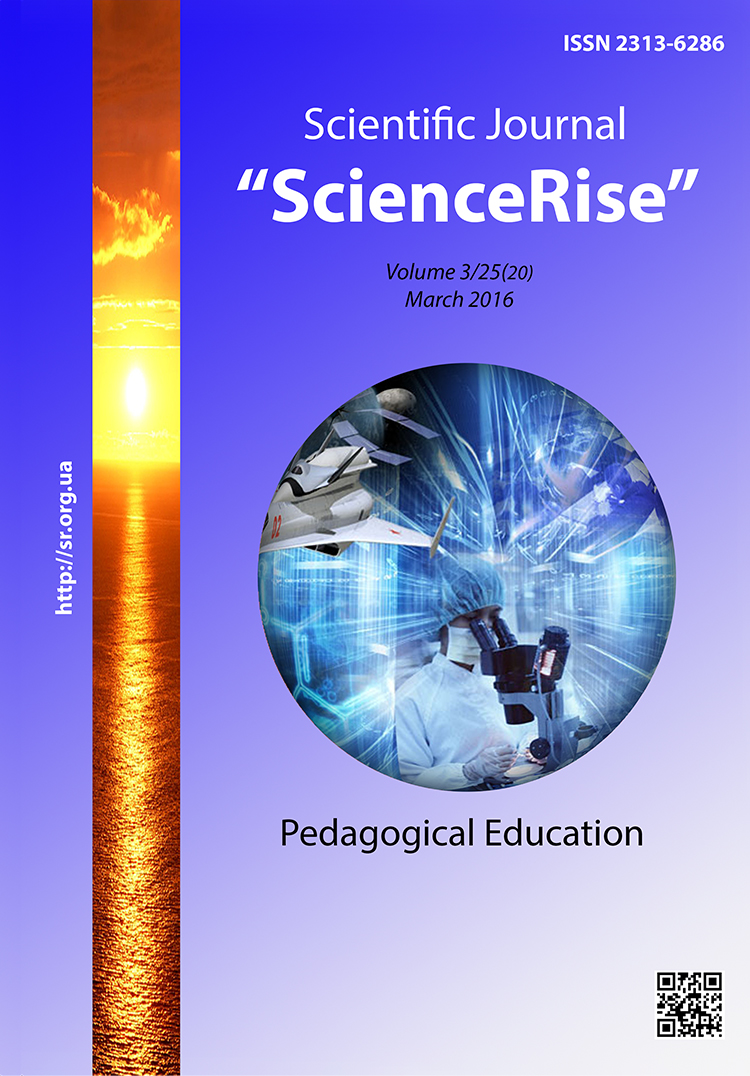Innovations in the higher school language education
DOI:
https://doi.org/10.15587/2313-8416.2016.64956Keywords:
innovative activity, innovative methods, language education, informative graphics, pedagogical innovationsAbstract
The article deals with innovations in the higher school language education. Authors note that innovations result in intensification of the educational process, guarantee its flexibility, diversify the program of studying languages in HEI, favor the growth of motivation, the involvement of students in the research activity, the development of creativity, elaboration of intellectual products, the creation of the favorable atmosphere for the students’ independent work.
In the offered article was studied the essence of the notion “innovation” and the importance of innovative technologies in education and also grounded the expedience of using informational graphics (infographics) as the one of the most effective innovative methods of studying languages in HEI, analyzed the main tasks, advantages of the use and principles of creation of infopraphics, determined the levels of complication of informational graphics elaboration, cited the examples of on-line services that allow create the static and dynamic infographicsReferences
Zagvjazinskij, V. I. (1990). Innovacionnye processy v obrazovanii i pedagogicheskaja nauka [Innovative processes in education and pedagogical science]. Innovative processes in education. Tjumen', 5–14.
Lazarev, V. S. (2002). Sistemnoe razvitie shkoly [System school development]. Moscow: Russian pedagogical Agency, 304.
Stepko, M. F., Boljubash, Ja. Ja., Shynkaruk, V. D., Grubinko, V. V., Babyn, I. I.; Kremen, V. H. (Ed.) (2004). Vyshcha osvita Ukrainy i Bolonskyi protses [Higher education of Ukraine and the Bologna process]. Ternopil: Navchalna knyha – Bohdan, 384.
Dubaseniuk, O. A.; Dubasenjuk, O. A. (Ed.) (2014). Innovatsii v suchasnii osviti [Innovations in modern education]. Innovations in education: integration of science and practice. Zhytomyr: Vyd-vo ZhDU im. I. Franka, 12–28.
Borysenko, V. V., Gagina, N. V. (2015). Informatsiino-komunikatsiini tekhnolohii yak sposib udoskonalennia movnoi pidhotovky studentiv vyshchoi shkoly [Information and communication technologies as a means of improving language training in high school]. Continuing professional education: theory and practice, 4, 95–99.
Suchasnyi slovnyk inshomovnykh sliv [Modern dictionary of foreign words] (2006). Kyiv: Dovira, 789.
Dychkivska, I. M. (2012). Innovatsiini pedahohichni tekhnolohii [Innovative pedagogical technologies]. Kyiv: Akademvydav, 352.
Polman, J. L., Gebre, E. H. (2015). Towards critical appraisal of infographics as scientific inscriptions. Journal of Research in Science Teaching, 52 (6), 868–893. doi: 10.1002/tea.21225
Sydor, Ya. (2013). Zastosuvannia infohrafiky v drukovanykh ZMI [The use of infographics in print media]. Chep. ІІ. Youth: education, science, spirituality. Kyiv, 124–125.
Kontsevoj, M.; Iuchankava, V. I. (Ed.) (2012). Interaktivnaja zhurnalistskaja infografika: fenomen, tendencii, instrumentarij [Interactive journalistic infographics: the phenomenon, trends, instruments]. Zhytstsem i slovam prysiahaiuchy. Minsk: Adukatsyia i vykhavanne, 298–307.
Bondarev, M. G. (2012). Ispol'zovanie infografiki kak instrumenta vizualizacii uchebnogo teksta v ramkah kursa «Inostrannyj jazyk dlja special'nyh celej» [Infographics as an instrument of educational text visualization within the course «Language for specific purposes»]. Informatics, computing and engineering education, 3 (10), 1–6. Available at: http://digital-mag.tti.sfedu.ru/lib/10/7-2012-3(10).pdf
Frolova, M. A. (2014). Infografika: novoe ili horosho zabytoe staroe? [Infographics: new or well-forgotten old?]. Young scientist, 13 (72), 10–13.
Kondratenko, O. A. (2013). Infografika v shkole i vuze: na puti k razvitiju vizual'nogo myshlenija [Infographics in school and universities: underway towards visual thinking development]. Scientific dialogue, 9 (21), 92–99.
Downloads
Published
Issue
Section
License
Copyright (c) 2016 Наталія Вікторівна Гагіна, Валентина Володимирівна Борисенко

This work is licensed under a Creative Commons Attribution 4.0 International License.
Our journal abides by the Creative Commons CC BY copyright rights and permissions for open access journals.
Authors, who are published in this journal, agree to the following conditions:
1. The authors reserve the right to authorship of the work and pass the first publication right of this work to the journal under the terms of a Creative Commons CC BY, which allows others to freely distribute the published research with the obligatory reference to the authors of the original work and the first publication of the work in this journal.
2. The authors have the right to conclude separate supplement agreements that relate to non-exclusive work distribution in the form in which it has been published by the journal (for example, to upload the work to the online storage of the journal or publish it as part of a monograph), provided that the reference to the first publication of the work in this journal is included.

